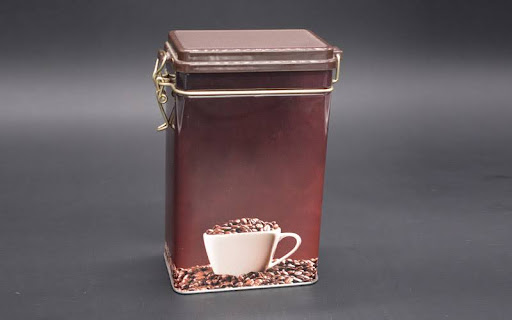When evaluating coffee tins, the durability of the lid is just as important as the integrity of the can itself. In recent market testing, lids accounted for 45% of total packaging failures due to dents, leaked seals, or broken hinges. Therefore, choosing the right lid design not only preserves freshness and extends shelf life but also reduces replacement costs and environmental waste. Standard lid designs for coffee cans include snap-on, clip-on, threaded, magnetic, lever-lock, gasket-sealed, and hybrids.
Durable Snap-On Lid Designs for Coffee Tins
Snap-on lids are one of the most common closures for coffee tins, prized for their ease of use and affordability. Manufacturers typically make these lids from tinplate or aluminum and design them with an inward-rolled flange that “snaps” into a corresponding groove on the can body. Key durability factors include the flange’s depth and radius, material toughness, and snap-on engagement strength. In commercial drop tests, snap-on coffee can lids with a 0.5 mm lip depth and a 0.8 mm can wall thickness remained resistant to denting and accidental loosening after 50 drops from a height of 1 meter. To extend service life, manufacturers specify a tensile strength of at least 280 MPa for the tinplate and apply an anti-corrosion coating. While snap-on lids excel in lightweight, high-volume packaging, they can loosen after repeated opening and closing cycles, making them best suited for everyday household use rather than high-traffic retail displays.
Industrial-strength clamp-ring lid designs for coffee tins
For brands requiring industrial-strength performance, clamp-ring lids on coffee tins offer enhanced mechanical retention. These systems utilize a separate metal or plastic ring to clamp the lid, applying uniform circumferential pressure to maintain a tight seal. In vacuum-sealed coffee packaging, clamp-ring lids can withstand an internal pressure differential of 0.5 bar and remain intact for 100 sealing cycles. The ring itself is typically made of galvanized steel or reinforced nylon with a tensile strength exceeding 600 MPa. Because the load is distributed through the ring, the lid’s bead can be thinner, allowing for more economical can sizes while maintaining overall strength. This design is particularly effective for large cans shipped internationally, which are subject to the most severe vibration and handling stresses.
Threaded cap design for precise reclosing
Though less common on coffee tins, threaded caps offer a precise reclosing mechanism, making them an ideal choice for high-quality reusable packaging. These caps feature either a continuous or interrupted thread design that screws onto the matching threads on the can, providing consistent engagement torque and a reliable mechanical interlock. In accelerated cycling tests, a threaded coffee can lid with a 1.5 mm pitch depth and a 30 mm thread diameter maintained structural integrity and leak-proofness after 5,000 opening and closing cycles.
Material selection, such as high-strength steel or aluminum alloy, helps improve durability without adding weight. Furthermore, combining a threaded cap with an inner gasket enhances aroma retention. While threaded designs have higher tooling costs, their superior durability and consumer perception of quality make them suitable for premium coffee brands.
Magnetic Lid Design for Seamless Convenience
Magnetic closures incorporate rare-earth magnets into the lid and rim of coffee tins, creating an elegant, tool-free resealing solution. In drop and pull tests, the magnetic coffee can lid, featuring a 10 × 2 mm magnet array, achieved a pull-off strength of 15 N and opens easily with a gentle pull.⁵ The lack of mechanical threads or snaps reduces wear on the metal rim, enhancing durability with repeated use.
Furthermore, the magnets can be embedded behind a thin tin plate, maintaining a seamless aesthetic. While integrating the magnets increases material costs by approximately 10%, the superior consumer experience and long-term reseal performance justify the investment in luxury coffee packaging.
Lever-Lock Lid Design for a High-Security Seal
The lever-lock lid on the coffee tin uses a cam-lever mechanism to clamp the lid to the can. When closing, the lever applies even pressure along the can’s circumference, providing a highly repeatable sealing force—typically calibrated to 20-30 N per lever engagement. These lids feature hardened steel cams and pivot pins, rated for over 10,000 cycles, ensuring long-lasting durability.
Lever-lock coffee tin lids excel in tamper-evident and child-resistant applications, with manufacturers often incorporating integrated latches or tamper-evident bands in their designs. While they add complexity and cost, they excel in the high-security, high-value coffee market, where freshness and integrity are of paramount importance.
Choosing the Most Durable Coffee Tin Lid Design
The most durable coffee tin lid design meets specific functional needs, from everyday convenience to industrial-grade sealing. Snap-on lids excel in cost-effective, high-volume applications. Clip-on systems provide strong mechanical retention, while threaded and magnetic lids enable precise reclosure. Lever-lock designs ensure high security. By integrating lid selection with brand positioning, distribution needs, and consumer preferences, you can select a coffee can lid that enhances your product’s market appeal and overall appeal.
ALSO READ: Turbo Media Site Demis Tech: Understanding Its Roles



